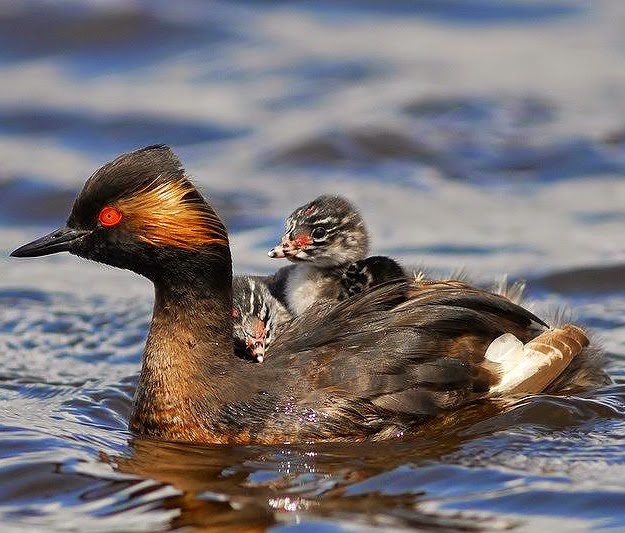 |
| Photo by Gerard Visser (Internet Bird Collection) |
Common name:
black-necked grebe (en); mergulhão-de-pescoço-preto (pt); grèbe à cou noir (fr); zampullín cuellinegro (es); schwarzhalstaucher (de)
Taxonomy:
Order Podicipediformes
Family Podicipedidae
Range:
This species occurs in three disjunct subspecies. P.n. nigricollis breeds from western Europe to western Asia, in central and eastern Asia as far as north-eastern China and extreme south-eastern Russia, and with a few population in East Africa. Some population migrate south to winter around the Mediterranean, in the Middle East and in Japan and southern China. P.n. gurneyi is found in southern Africa, and P.n. californicus breeds in south-western Canada and in the western United States and migrates south as far as Guatemala.
Size:
These birds are 28-34 cm long and have a wingspan of 56-60 cm long. They weigh 265-450 g.
Habitat:
The black-necked grebe breeds in small, shallow, highly eutrophic water bodies with lush vegetation, such as freshwater marshes and lakes, also using reed beds, fish ponds and sewage farms. Outside the breeding season they use saltwater lakes, estuaries, saltpans, and inshore shallow bays and channels.
Diet:
They feed mainly on adult and larval insects, such as aquatic bugs, beetles, damselflies, dragonflies, midges and brine flies, also taking snails, crustaceans such as brine shrimps, polychaete worms, small frogs and tadpoles, and small fish.
Breeding:
Black-necked grebes can breed all year round, varying among different parts of their range. They are monogamous and often nest in dense colonies. Each pair build a nest that consists of a mound of algae and other soft plant matter, anchored on an underwater plant in open water. There the female lays 2-5 eggs which are incubated by both parents for 20-22 days. The chicks leave the nest immediately after hatching, and are fed and carried on the backs of both parents until they fledge, about 21 days after hatching.
Conservation:
IUCN status – LC (Least Concern)
This species has a very large breeding range and the global population is estimated at 3,9-4,2 million individuals, possibly being the most numerous of all grebes. The overall population trend is uncertain, as some populations are decreasing, while others are stable, have unknown trends or are increasing.







